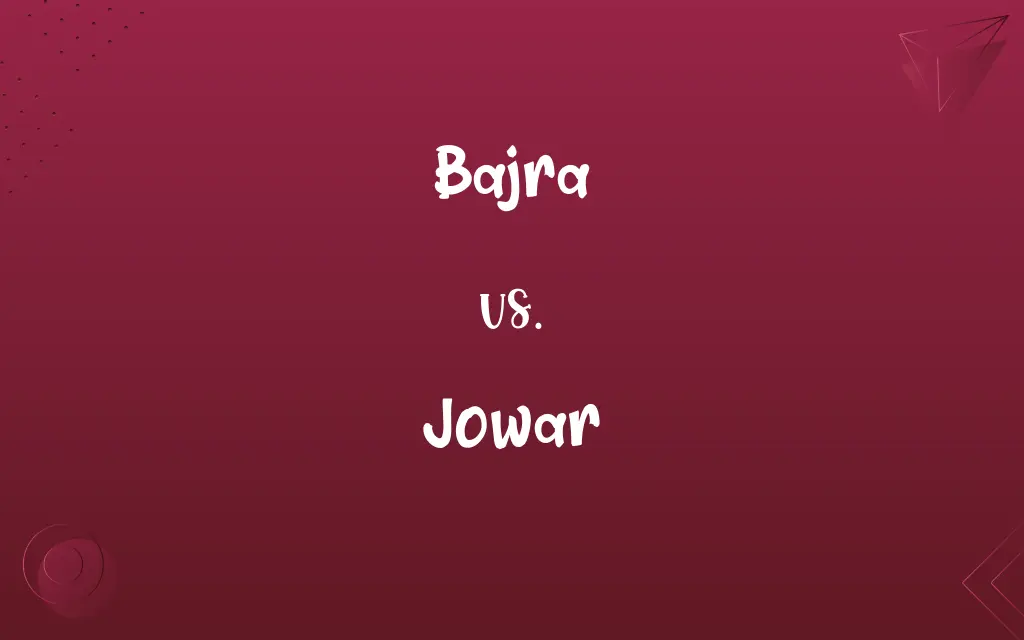Bajra vs. Jowar: Know the Difference

By Shumaila Saeed || Updated on February 20, 2024
Bajra (pearl millet) is a small-seeded cereal with high heat tolerance, while Jowar (sorghum) is a larger-seeded cereal better suited for cooler climates.

Key Differences
Bajra, known as pearl millet, is a small-grained cereal crop primarily grown in arid and semi-arid regions due to its high drought resistance. Jowar, or sorghum, is a cereal with larger grains, cultivated in a wider range of climates including temperate zones.
Shumaila Saeed
Feb 18, 2024
Nutritionally, Bajra is rich in protein, fiber, and essential minerals, making it a staple in many diets in dry areas. Jowar, comparatively, is known for its energy content and is often used in gluten-free diets.
Shumaila Saeed
Feb 18, 2024
In terms of culinary uses, Bajra is often ground into flour for bread and porridge. Jowar, on the other hand, is versatile, used in flours, syrups, and as a whole grain.
Shumaila Saeed
Feb 18, 2024
Bajra has a distinct nutty flavor and is a key ingredient in traditional dishes in parts of Africa and Asia. Jowar, with a milder taste, is commonly found in African, Asian, and American cuisines.
Shumaila Saeed
Feb 18, 2024
Agronomically, Bajra grows well in poor soil conditions and matures quickly. Jowar requires more water than Bajra but is adaptable to various soil types.
Shumaila Saeed
Feb 18, 2024
ADVERTISEMENT
Comparison Chart
Climate Adaptation
Thrives in arid and semi-arid regions.
Suited for a wider range, including cooler climates.
Shumaila Saeed
Feb 18, 2024
Nutritional Value
High in protein, fiber, and minerals.
Rich in energy, suitable for gluten-free diets.
Shumaila Saeed
Feb 18, 2024
Culinary Uses
Mainly in bread and porridge.
Used in flours, syrups, and whole grain.
Shumaila Saeed
Feb 18, 2024
Agronomic Needs
Grows in poor soils, drought-resistant.
Requires more water, adaptable to various soils.
Shumaila Saeed
Feb 18, 2024
ADVERTISEMENT
Bajra and Jowar Definitions
Bajra
It's a traditional grain in African and Asian cuisines.
Bajra porridge is a common breakfast in parts of Africa.
Shumaila Saeed
Jan 13, 2024
Jowar
Jowar is a versatile cereal grain known as sorghum.
Jowar is often used to make gluten-free bread.
Shumaila Saeed
Jan 13, 2024
Bajra
Bajra is a drought-resistant cereal crop.
Bajra thrives in the dry soils of Rajasthan.
Shumaila Saeed
Jan 13, 2024
Jowar
Jowar grows well in various soil types, requiring moderate water.
Jowar fields are a common sight in temperate regions.
Shumaila Saeed
Jan 13, 2024
Bajra
Bajra is a source of protein and dietary fiber.
Bajra rotis are both nutritious and filling.
Shumaila Saeed
Jan 13, 2024
ADVERTISEMENT
Jowar
Jowar is rich in energy and suitable for gluten-free diets.
Jowar flour is a popular alternative in gluten-free baking.
Shumaila Saeed
Jan 13, 2024
Bajra
It's known for its small, pearl-like grains.
Bajra flour is a staple in many rural households.
Shumaila Saeed
Jan 13, 2024
Jowar
It's characterized by its larger, nutritious seeds.
Jowar seeds are ground into a fine flour for various dishes.
Shumaila Saeed
Jan 13, 2024
Bajra
Bajra adapts well to nutrient-poor soils.
Bajra cultivation supports farmers in arid regions.
Shumaila Saeed
Jan 13, 2024
Jowar
It's a staple in African, Asian, and American cuisines.
Jowar is commonly used in traditional African porridges.
Shumaila Saeed
Jan 13, 2024
Repeatedly Asked Queries
What climates are suitable for Jowar cultivation?
It grows well in a range of climates, including temperate zones.
Shumaila Saeed
Feb 18, 2024
Can Bajra be used in baking?
Yes, it's commonly ground into flour for bread.
Shumaila Saeed
Feb 18, 2024
Is Bajra nutritionally beneficial?
Yes, it's high in protein, fiber, and essential minerals.
Shumaila Saeed
Feb 18, 2024
Where is Bajra commonly grown?
In arid and semi-arid regions, especially in Africa and Asia.
Shumaila Saeed
Feb 18, 2024
What are the health benefits of Jowar?
Jowar is energy-rich and suitable for gluten-free diets.
Shumaila Saeed
Feb 18, 2024
Is Bajra easy to cultivate?
Yes, it grows well in poor soil conditions and matures quickly.
Shumaila Saeed
Feb 18, 2024
What are the culinary uses of Jowar?
Used in flours, syrups, and as a whole grain in various dishes.
Shumaila Saeed
Feb 18, 2024
What dishes are commonly made with Bajra?
Bajra is used in rotis, porridge, and various traditional dishes.
Shumaila Saeed
Feb 18, 2024
Can Bajra be eaten whole?
It's typically consumed as flour, but can be eaten whole in some dishes.
Shumaila Saeed
Feb 18, 2024
What are some popular Jowar recipes?
Jowar is used in bread, porridge, and as a rice alternative.
Shumaila Saeed
Feb 18, 2024
Does Bajra require a lot of water to grow?
No, it's highly drought-resistant and requires minimal water.
Shumaila Saeed
Feb 18, 2024
Can Jowar be a part of a gluten-free diet?
Absolutely, Jowar is a great gluten-free grain option.
Shumaila Saeed
Feb 18, 2024
What are the agronomic needs of Jowar?
It requires more water than Bajra and adapts to various soils.
Shumaila Saeed
Feb 18, 2024
Is Jowar consumed as whole grains?
Yes, Jowar can be eaten as whole grains, especially in porridges.
Shumaila Saeed
Feb 18, 2024
Share this page
Link for your blog / website
HTML
Link to share via messenger
About Author
Written by
Shumaila SaeedShumaila Saeed, an expert content creator with 6 years of experience, specializes in distilling complex topics into easily digestible comparisons, shining a light on the nuances that both inform and educate readers with clarity and accuracy.








































































